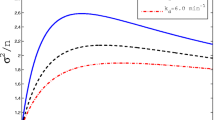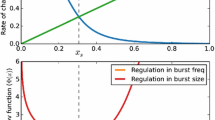Abstract
RNA and protein concentrations within cells constantly fluctuate. Some molecular species typically have very low copy numbers, so stochastic changes in their abundances can dramatically alter cellular concentration levels. Such noise can be harmful through constrained functionality or reduced efficiency. Gene regulatory networks have evolved to be robust in the face of noise. We obtain exact analytical expressions for noise dissipation in an idealised stochastic model of a gene regulatory network. We show that noise decays exponentially fast. The decay rate for RNA molecular counts is given by the integral of the tail of the cumulative distribution function of the degradation time. For proteins, it is given by the slowest rate-limiting step of RNA degradation or proteolytic breakdown. This is intuitive because memory of the chemical composition of the system is manifested through molecular persistence. The results are obtained by analysing a non-standard tandem of infinite server queues, in which the number of customers present in one queue modulates the arrival rate into the next.




Similar content being viewed by others
Availability of data and material.
Not applicable.
References
Arazi A, Ben-Jacob E, Yechiali U (2004) Bridging genetic networks and queueing theory. Physica A 332:585–616
Asmussen S (2003) Applied Probability and Queues. Stochastic Modelling and Applied Probability, 2nd edn. Springer, New York, NY
Beck J, Reidenbach D, Salomon N et al (2021) mRNA therapeutics in cancer. Mol Cancer 20:69
Cao Z, Grima R (2020) Analytical distributions for detailed models of stochastic gene expression in eukaryotic cells. Proc Natl Acad Sci USA 117:4682–4692
Cookson N, Mather W, Danino T, Mondragón-Palomino O, Williams R, Tsimring L, Hasty J (2011) Queueing up for enzymatic processing: correlated signaling through coupled degradation. Mol Syst Biol 7:561
Crick F (1970) Central Dogma of Molecular Biology. Nature 227:221–237
Czuppon P, Pfaffelhuber P (2018) Limits of noise for autoregulated gene expression. J Math Biol 77:1153–1191
Dean J, Ganesh A, Crane E (2020) Functional large deviations for Cox processes and \(Cox/G/\infty \) queues, with a biological application. Ann Appl Probab 30(5):2465–2490
De Jong H (2002) Modeling and Simulation of Genetic Regulatory Systems: A Literature Review. J Comput Biol 9(1):67–103
Dessalles R, Fromion V, Robert P (2017) A stochastic analysis of autoregulation of gene expression. J Math Biol 75:1253–1283
Fromion V, Leoncini E, Robert P (2013) Stochastic Gene Expression in Cells: A Point Process Approach. SIAM J Appl Math 73(1):195–211
Gelenbe E (2007) Steady-state solution of probabilistic gene regulatory networks. Phys Rev E 76:031903
Giovanini G, Barros L, Gama L, Tortelli T Jr, Ramos A (2022) A Stochastic Binary Model for the Regulation of Gene Expression to Investigate Responses to Gene Therapy. Cancers 14(3):633
Harchol-Balter M (2013) Performance Modeling and Design of Computer Systems: Queueing Theory in Action. Cambridge University Press
Horn R, Johnson C (2013) Matrix Analysis, 2nd edn. Cambridge University Press
Jia C, Grima R (2021) Frequency Domain Analysis of Fluctuations of mRNA and Protein Copy Numbers within a Cell Lineage: Theory and Experimental Validation. Phys Rev X 11:021032
Kauffman SA (1969) Metabolic stability and epigenesis in randomly constructed genetic nets. J Theor Biol 22:437–467
Kendall DG (1953) Stochastic Processes Occurring in the Theory of Queues and their Analysis by the Method of the Imbedded Markov Chain. Ann Math Stat 24(3):338
Kishi Y, Kino I (2006) Closed Form of PH-Distributions. J Oper Res Soc Japan 49:98–116
Komárková Z (2012) Phase-type Approximation Techniques. Bachelor Thesis, Masaryk University, Faculty of Informatics
Last G, Penrose M (2017) Lectures on the Poisson Process. Cambridge University Press
Lee J, Yesilkanal A, Wynne J, Frankenberger C, Liu J et al (2019) Effective breast cancer combination therapy targeting BACH1 and mitochondrial metabolism. Nature 568:254–258
Lestas I, Paulsson J, Ross N, Vinnicombe G (2008) Noise in Gene Regulatory Networks. IEEE T Automat Contr 53:189–200
Liu L, Kashyap B, Templeton J (1990) On the \(GI^X/G/\infty \) System. J Appl Prob 27(3):671–683
Mather W, Cookson N, Hasty J, Tsimring L, Williams R (2010) Correlation resonance generated by coupled enzymatic processing. Biophys J 99:3172–3181
Mather W, Hasty J, Tsimring L, Williams R (2011) Factorized time-dependent distributions for certain multiclass queueing networks and an application to enzymatic processing networks. Queueing Syst 69:313–328
Mather W, Hasty J, Tsimring L, Williams R (2013) Translational cross talk in gene networks. Biophys J 104:2564–2572
Paulsson J (2005) Models of stochastic gene expression. Phys Life Rev 2:157–175
Ramos A, Hornos J, Reinitz J (2015) Gene regulation and noise reduction by coupling of stochastic processes. Phys Rev E 91:020701(R)
Ramos A, Reinitz J (2019) Physical implications of SO(2,1) symmetry in exact solutions for a self-repressing gene. J Chem Phys 151:041101
Royden H, Fitzpatrick P (2010) Real Analysis, 4th edn. Pearson
Smolen P, Baxter DA, Byrne JH (2000) Modeling transcriptional control in gene networks - Methods, recent results, and future directions. B Math Biol 62:247–292
Thattai M, van Oudenaarden A (2001) Intrinsic noise in gene regulatory networks. Proc Natl Acad Sci USA 98:8614–8619
Thattai M (2016) Universal Poisson Statistics of mRNAs with Complex Decay Pathways. Biophys J 110(2):301–305
Zhang Z, Liang J, Wang Z, Zhang J, Zhou T (2020) Modeling stochastic gene expression: From Markov to non-Markov models. Math Biosci Eng 17(5):5304–5325
Acknowledgements
We would like to thank the anonymous reviewers for their comments and suggestions, which greatly improved the quality of the exposition.
Funding
The first author was supported by an EPSRC PhD studentship grant: EP/M506473/1.
Author information
Authors and Affiliations
Corresponding author
Ethics declarations
Conflicts of Interest
Not applicable
Code Availability
Not applicable.
Additional information
Publisher's Note
Springer Nature remains neutral with regard to jurisdictional claims in published maps and institutional affiliations.
Appendix
Appendix
In this section we reproduce a number of definitions from Last and Penrose (2017) for the convenience of the reader.
Let \(\left( \mathbb {X},{\mathcal {X}}\right) \) be a measurable space. Let the space of all measures \(\mu \) on \(\mathbb {X}\) with the property that \(\mu (A)\in \mathbb {N}_0\) for any \(A\in {\mathcal {X}}\), be denoted by \({{\textbf {N}}}_{<\infty }(\mathbb {X})\), or just \({{\textbf {N}}}_{<\infty }\) for short. Now write \({{\textbf {N}}}(\mathbb {X})\) (or just \({{\textbf {N}}}\) for short) for the space of all measures that can be written as a countable sum of elements of \({{\textbf {N}}}_{<\infty }\). We define the \(\sigma \)-algebra \({\mathcal {N}}\) on \({{\textbf {N}}}\) by
Definition 10
(Last and Penrose (2017) Definition 2.1) Given a probability space \(\left( {\varOmega },{\mathcal {F}},{{\mathbb {P}}}\right) \), a point process on \(\mathbb {X}\) is a measurable mapping \(\eta :{\varOmega }\rightarrow {{\textbf {N}}}\).
Definition 11
(Last and Penrose (2017) Definition 2.5) The intensity measure of a point process \(\eta \) on \(\mathbb {X}\), is the measure \(\lambda \) defined by \(\lambda (A):=\mathbb {E}[\eta (A)]\), where \(A\in {\mathcal {X}}\).
Note that \(\lambda (A)\) is well-defined, though possibly infinite because \(\eta (A)\) is a non-negative random variable.
Definition 12
(Last and Penrose (2017) Page 10) We say that a measure \(\nu \) on \(\mathbb {X}\) is s-finite if it is a countable sum of finite measures.
Definition 13
(Last and Penrose (2017) Definition 3.1) Let \(\lambda \) be an s-finite measure on \(\mathbb {X}\). A Poisson process with intensity measure \(\lambda \) is a point process \(\eta \) on \(\mathbb {X}\) with the following two properties:
-
1.
For every \(B\in {\mathcal {X}}\), the distribution of \(\eta (B)\) is Poisson with parameter \(\lambda (B)\).
-
2.
For every \(m\in \mathbb {N}\) and all pairwise disjoint sets \(B_1,\ldots ,B_m\in {\mathcal {X}}\) the random variables \(\eta (B_1),\ldots ,\eta (B_m)\) are mutually independent.
Denote by \({{\textbf {M}}}(\mathbb {X})={{\textbf {M}}}\), the set of s-finite measures on \(\mathbb {X}\). We denote by \({\mathcal {M}}(\mathbb {X})={\mathcal {M}}\) the \(\sigma \)-algebra generated by \(\left\{ \mu \in {{\textbf {M}}}:\mu (B)\le t\right\} ,B\in {\mathcal {X}},t\in \mathbb {R}_+\). This \(\sigma \)-algebra is the smallest possible to make the mappings \(\mu \mapsto \mu (B)\) measurable for all B in \({\mathcal {X}}\).
In what follows there is a fixed probability space \(({\varOmega },{\mathcal {F}},{{\mathbb {P}}})\) on which all random elements are defined.
Definition 14
(Last and Penrose (2017) Definition 13.1) A random measure on \(\mathbb {X}\) is a random element \(\xi \) of the space \(({{\textbf {M}}},{\mathcal {M}})\), that is, a measurable mapping \(\xi :{\varOmega }\rightarrow {{\textbf {M}}}\).
Now let \(\lambda \in {{\textbf {M}}}(\mathbb {X})\) and write \({\varPi }_{\lambda }\) to denote the distribution of a Poisson point process with intensity measure \(\lambda \). Theorem 3.6 of Last and Penrose (2017) guarantees that such a process exists.
Definition 15
(Last and Penrose (2017) Definition 13.5) Let \(\xi \) be a random measure on \(\mathbb {X}\). A point process \(\eta \) on \(\mathbb {X}\) is called a Cox process directed by \(\xi \) if
Then \(\xi \) is called a directing random measure of \(\eta \).
Rights and permissions
Springer Nature or its licensor holds exclusive rights to this article under a publishing agreement with the author(s) or other rightsholder(s); author self-archiving of the accepted manuscript version of this article is solely governed by the terms of such publishing agreement and applicable law.
About this article
Cite this article
Dean, J., Ganesh, A. Noise dissipation in gene regulatory networks via second order statistics of networks of infinite server queues. J. Math. Biol. 85, 14 (2022). https://doi.org/10.1007/s00285-022-01781-9
Received:
Revised:
Accepted:
Published:
DOI: https://doi.org/10.1007/s00285-022-01781-9




